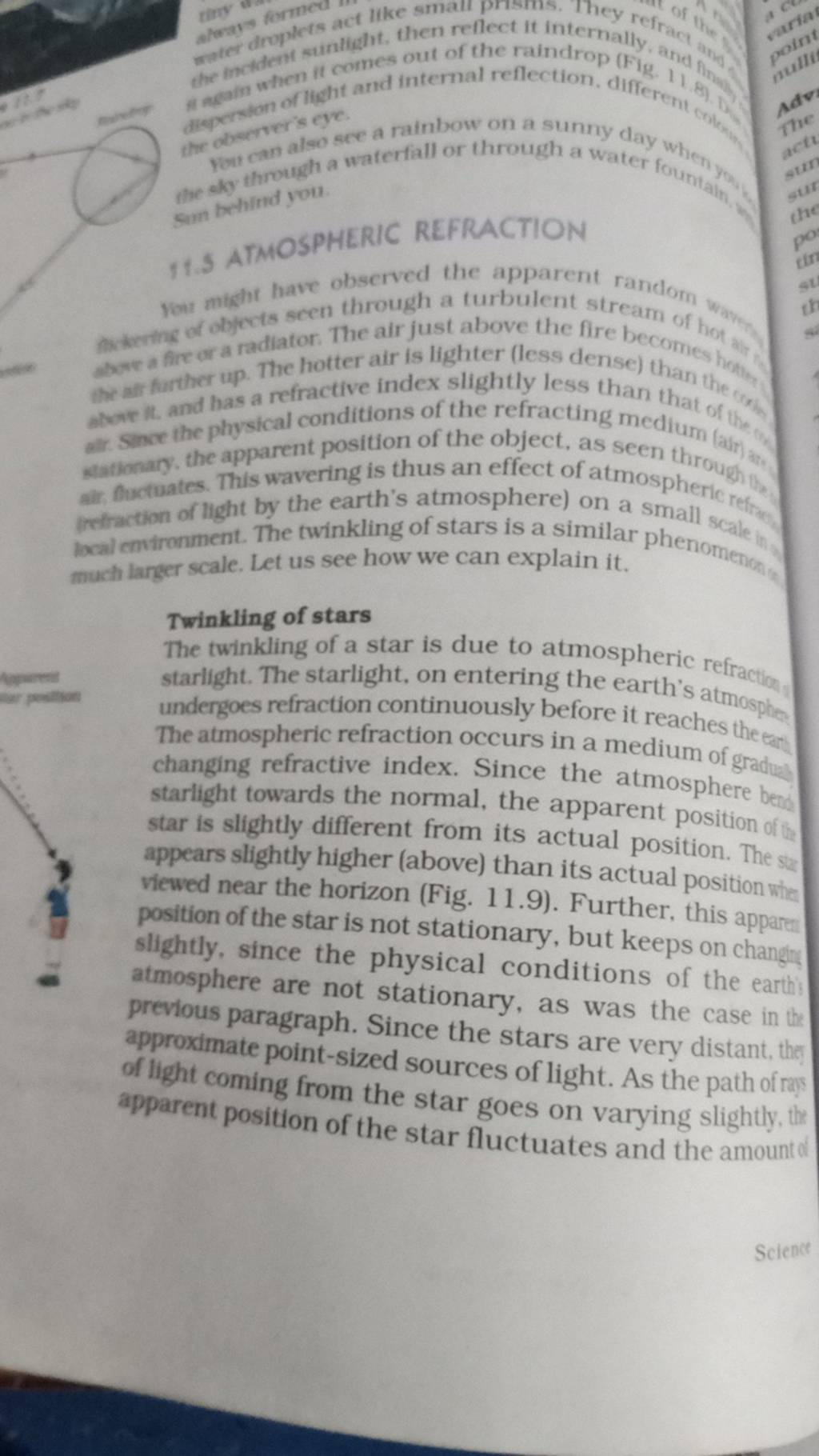Question
Question asked by Filo student

the olyeerverie eyr the eky through 11.5 ATMOSPHERIC REFRACTION Yout mikht have observed the apparent random wo swderthg of objects seen through a turbulent stream of hiot, wove a fire or a radiator. The air just above the fire becomes her he hir is lighter (less dense) than above in and has a refractive index sitions of the refracting medium the the to atarionary, the apparent position of the object, as seen through air fuctuates. This wavering is thus an effect of atmospheric refes (irfraction of light by the earth's atmosphere) on a small scale ing focal emironment. The twinkling of stars is a similar Twinkling of stars The twinkling of a star is due to atmospheric refraction. starlight. The starlight, on entering the earth's atmospone undergoes refraction continuously before it reaches the end The atmospheric refraction occurs in a medium of graduey changing refractive index. Since the atmosphere beess starlight towards the normal, the apparent position of star is slightly different from its actual position. The se appears slightly higher (above) than its actual position wing viewed near the horizon (Fig. 11.9). Further, this apparici position of the star is not stationary, but keeps on changy. slightly, since the physical conditions of the eartix atmosphere are not stationary, as was the case in previous paragraph. Since the stars are very distant, thing of fight coming point-sized sources of light. As the path ofrepp of light coming from the star goes on varying slightly, tin apparent position of the star fluctuates and the amountol Science
Found 6 tutors discussing this question
Discuss this question LIVE
5 mins ago

One destination to cover all your homework and assignment needs
Learn Practice Revision Succeed

Instant 1:1 help, 24x7
60, 000+ Expert tutors

Textbook solutions
Big idea maths, McGraw-Hill Education etc

Essay review
Get expert feedback on your essay

Schedule classes
High dosage tutoring from Dedicated 3 experts
Practice more questions on Physics
Question 2
Easy
Views: 5,421
Question 4
Easy
Views: 5,437
Students who ask this question also asked
Question 1
Views: 5,179
Question 2
Views: 5,204
Question 3
Views: 5,468
Question 4
Views: 5,212


Stuck on the question or explanation?
Connect with our Science tutors online and get step by step solution of this question.
231 students are taking LIVE classes
| Question Text | the olyeerverie eyr
the eky through
11.5 ATMOSPHERIC REFRACTION
Yout mikht have observed the apparent random wo swderthg of objects seen through a turbulent stream of hiot, wove a fire or a radiator. The air just above the fire becomes her he hir is lighter (less dense) than above in and has a refractive index sitions of the refracting medium the the to atarionary, the apparent position of the object, as seen through air fuctuates. This wavering is thus an effect of atmospheric refes (irfraction of light by the earth's atmosphere) on a small scale ing focal emironment. The twinkling of stars is a similar
Twinkling of stars
The twinkling of a star is due to atmospheric refraction. starlight. The starlight, on entering the earth's atmospone undergoes refraction continuously before it reaches the end The atmospheric refraction occurs in a medium of graduey changing refractive index. Since the atmosphere beess starlight towards the normal, the apparent position of star is slightly different from its actual position. The se appears slightly higher (above) than its actual position wing viewed near the horizon (Fig. 11.9). Further, this apparici position of the star is not stationary, but keeps on changy. slightly, since the physical conditions of the eartix atmosphere are not stationary, as was the case in previous paragraph. Since the stars are very distant, thing of fight coming point-sized sources of light. As the path ofrepp of light coming from the star goes on varying slightly, tin apparent position of the star fluctuates and the amountol
Science |
| Updated On | Jul 28, 2022 |
| Topic | Physics |
| Subject | Science |
| Class | Class 10 |
| Answer Type | Video solution: 1 |
| Upvotes | 136 |
| Avg. Video Duration | 19 min |



